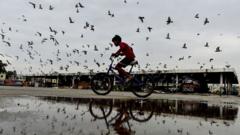The recent ban on feeding pigeons in Mumbai has triggered heated protests and debates between health officials and bird enthusiasts. While the government cites health risks from pigeon droppings, supporters highlight the cultural significance and community ties associated with pigeon feeding.
Mumbai's Pigeon Feeding Ban: A Clash of Health and Cultural Heritage

Mumbai's Pigeon Feeding Ban: A Clash of Health and Cultural Heritage
Controversy erupts in Mumbai as a court ruling bans pigeon feeding, igniting protests from community members and raising questions about public health versus cultural practices.
In a vibrant yet contentious conflict, Mumbai's civic authorities have imposed a ban on pigeon feeding in public areas due to rising health concerns stemming from pigeon droppings. This prohibition has resulted in a passionate outcry from bird lovers, community groups, and religious organizations who view the act of feeding pigeons as an integral part of their cultural heritage.
Protests have erupted following the shutdown of prominent pigeon feeding spots, with demonstrators clashing with police and threatening hunger strikes. The Jain community, in particular, advocates for pigeon feeding as a religious obligation, arguing that it plays a crucial role in Mumbai's historical landscape.
As pigeons are celebrated symbols of peace and coexistence, the sociocultural implications of their feeding extend beyond mere animal welfare. Many residents, like Syed Ismat, consider their relationship with these birds familial, highlighting their innocent nature and the kindness they inspire.
Despite the heartfelt appeals from animal rights activists and community members, studies have indicated that pigeon populations have surged significantly, exacerbating public health risks. According to experts, pigeon droppings can transmit numerous diseases, leading to respiratory and pulmonary ailments in humans. The data suggests an alarming increase of over 150% in pigeon numbers in India since 2000.
Delhi's civic authorities have taken note of similar concerns, suggesting similar measures to restrict pigeon feeding. The situation raises complex questions about how urban communities can reconcile cultural traditions with ongoing health risks.
In an attempt to address these challenges, some advocates propose regulated feeding times to maintain hygiene while ensuring the wellbeing of both the birds and residents. The Bombay High Court has set forth plans to establish an expert panel to explore collaborative solutions moving forward.
While the future of pigeon feeding remains uncertain, voices like Ismat’s emphasize the need for a new approach to urban wildlife coexistence, aiming for harmony between both nature and public health. As this multifaceted debate continues, it is clear that finding common ground will be essential for the flourishing of both Mumbai’s heritage and its residents' health.
Protests have erupted following the shutdown of prominent pigeon feeding spots, with demonstrators clashing with police and threatening hunger strikes. The Jain community, in particular, advocates for pigeon feeding as a religious obligation, arguing that it plays a crucial role in Mumbai's historical landscape.
As pigeons are celebrated symbols of peace and coexistence, the sociocultural implications of their feeding extend beyond mere animal welfare. Many residents, like Syed Ismat, consider their relationship with these birds familial, highlighting their innocent nature and the kindness they inspire.
Despite the heartfelt appeals from animal rights activists and community members, studies have indicated that pigeon populations have surged significantly, exacerbating public health risks. According to experts, pigeon droppings can transmit numerous diseases, leading to respiratory and pulmonary ailments in humans. The data suggests an alarming increase of over 150% in pigeon numbers in India since 2000.
Delhi's civic authorities have taken note of similar concerns, suggesting similar measures to restrict pigeon feeding. The situation raises complex questions about how urban communities can reconcile cultural traditions with ongoing health risks.
In an attempt to address these challenges, some advocates propose regulated feeding times to maintain hygiene while ensuring the wellbeing of both the birds and residents. The Bombay High Court has set forth plans to establish an expert panel to explore collaborative solutions moving forward.
While the future of pigeon feeding remains uncertain, voices like Ismat’s emphasize the need for a new approach to urban wildlife coexistence, aiming for harmony between both nature and public health. As this multifaceted debate continues, it is clear that finding common ground will be essential for the flourishing of both Mumbai’s heritage and its residents' health.


















